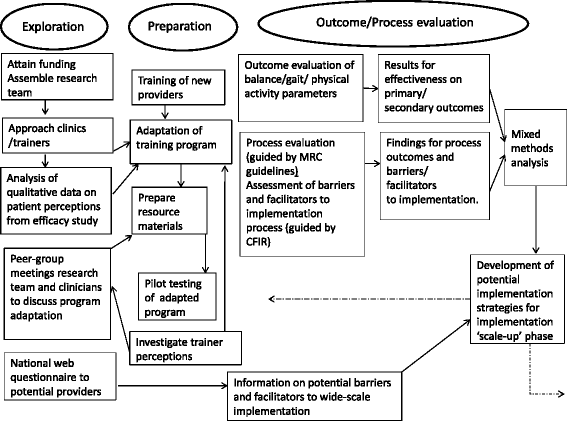Evaluation and implementation of highly challenging balance training in clinical practice for people with Parkinson's disease: protocol for the HiBalance effectiveness-implementation trial
- PMID: 28173775
- PMCID: PMC5297172
- DOI: 10.1186/s12883-017-0809-2
Evaluation and implementation of highly challenging balance training in clinical practice for people with Parkinson's disease: protocol for the HiBalance effectiveness-implementation trial
Abstract
Background: If people with progressive neurological diseases are to avail of evidence-based rehabilitation, programs found effective in randomized controlled trials (RCT's) must firstly be adapted and tested in clinical effectiveness studies as a means of strengthening their evidence base. This paper describes the protocol for an effectiveness-implementation trial that will assess the clinical effectiveness of a highly challenging balance training program (the HiBalance program) for people with mild-moderate Parkinson's disease (PD) while simultaneously collecting data concerning the way in which the program is implemented. The HiBalance program is systemically designed to target balance impairments in PD and has been shown effective at improving balance control and gait in a previous RCT. Study aims are to i) determine the effectiveness of the adapted HiBalance program on performance and self-rated outcomes such as balance control, gait and physical activity level ii) conduct a process evaluation of program implementation at the various clinics iii) determine barriers and facilitators to program implementation in these settings.
Methods: This effectiveness-implementation type 1 hybrid study will use a non-randomized controlled design with consecutive inclusion of people with PD at multiple clinical sites. A mixed method approach will be used to collect clinical effectiveness data and process evaluation data which is both quantitative and qualitative in nature. The consolidated framework for implementation research (CFIR) will be used to guide the planning and collection of data concerning implementation barriers and facilitators. The HiBalance program will be provided by physical therapists as a part of standard rehabilitation care at the clinical sites, while the evaluation of the implementation process will be performed by the research group and funded by research grants.
Discussion: An effectiveness-implementation study design benefits patients by speeding up the process of translating findings from research settings to routine health care. Findings from this study will also be highly relevant for those working with neurological rehabilitation when faced with decisions concerning the translation of training programs from efficacy studies to everyday clinical practice.
Trial registration: ClinicalTrials.gov march 2016, NCT02727478 .
Keywords: Balance training; Effectiveness-implementation; Parkinson’s disease; Pragmatic study design.
Figures
Similar articles
-
Implementation of the HiBalance training program for Parkinson's disease in clinical settings: A feasibility study.Brain Behav. 2018 Aug;8(8):e01021. doi: 10.1002/brb3.1021. Epub 2018 Jun 21. Brain Behav. 2018. PMID: 29931778 Free PMC article.
-
The EXPANd trial: effects of exercise and exploring neuroplastic changes in people with Parkinson's disease: a study protocol for a double-blinded randomized controlled trial.BMC Neurol. 2019 Nov 12;19(1):280. doi: 10.1186/s12883-019-1520-2. BMC Neurol. 2019. PMID: 31718583 Free PMC article. Clinical Trial.
-
Implementation of highly challenging balance training for Parkinson's disease in clinical practice: a process evaluation.BMC Geriatr. 2021 Feb 1;21(1):96. doi: 10.1186/s12877-021-02031-1. BMC Geriatr. 2021. PMID: 33526031 Free PMC article.
-
Effects of Exercise on Falls, Balance, and Gait Ability in Parkinson's Disease: A Meta-analysis.Neurorehabil Neural Repair. 2016 Jul;30(6):512-27. doi: 10.1177/1545968315613447. Epub 2015 Oct 21. Neurorehabil Neural Repair. 2016. PMID: 26493731 Review.
-
Motor learning in people with Parkinson's disease: Implications for fall prevention across the disease spectrum.Gait Posture. 2018 Mar;61:311-319. doi: 10.1016/j.gaitpost.2018.01.026. Epub 2018 Jan 31. Gait Posture. 2018. PMID: 29413803 Review.
Cited by
-
Analysis of the WHO ICTRP for novel coronavirus clinical trial registrations.Medicine (Baltimore). 2020 Oct 23;99(43):e22840. doi: 10.1097/MD.0000000000022840. Medicine (Baltimore). 2020. PMID: 33120812 Free PMC article.
-
Feasibility Aspects of Exploring Exercise-Induced Neuroplasticity in Parkinson's Disease: A Pilot Randomized Controlled Trial.Parkinsons Dis. 2020 Mar 25;2020:2410863. doi: 10.1155/2020/2410863. eCollection 2020. Parkinsons Dis. 2020. PMID: 32300475 Free PMC article.
-
Barriers to Participation in Therapeutic Clinical Trials as Perceived by Community Oncologists.JCO Oncol Pract. 2020 Sep;16(9):e849-e858. doi: 10.1200/JOP.19.00662. Epub 2020 Apr 2. JCO Oncol Pract. 2020. PMID: 32240068 Free PMC article.
-
Implementation of the HiBalance training program for Parkinson's disease in clinical settings: A feasibility study.Brain Behav. 2018 Aug;8(8):e01021. doi: 10.1002/brb3.1021. Epub 2018 Jun 21. Brain Behav. 2018. PMID: 29931778 Free PMC article.
-
Using Implementation Frameworks to Provide Proactive Physical Therapy for People With Parkinson Disease: Case Report.Phys Ther. 2019 Dec 16;99(12):1644-1655. doi: 10.1093/ptj/pzz129. Phys Ther. 2019. PMID: 31508801 Free PMC article.
References
-
- Parashos SA, et al. Falls in Parkinson disease: analysis of a large cross-sectional cohort. J Parkinsons Dis. 2013;3(4):515–22. - PubMed
Publication types
MeSH terms
Associated data
LinkOut - more resources
Full Text Sources
Other Literature Sources
Medical


